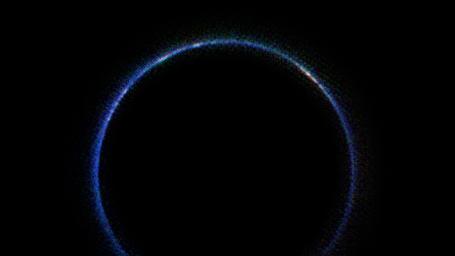
|
Pluto’s Blue Atmosphere in the Infrared
- Click the image above for a larger view
- Full-Res JPEG (841 x 473) (20.4 kB)
- Full-Res TIFF (841 x 473) (256.9 kB)
Caption:
This image from NASA's New Horizons spacecraft is the first look at Pluto's atmosphere in infrared wavelengths, and the first image of the atmosphere made with data from the New Horizons Ralph/Linear Etalon Imaging Spectral Array (LEISA) instrument.
In this image, sunlight is coming from above and behind Pluto. The image was captured on July 14, 2015, while New Horizons was about 112,000 miles (180,000 kilometers) away. The image covers LEISA's full spectral range (1.25 to 2.5 microns), which is divided into thirds, with the shortest third being put into the blue channel, middle third into the green channel, and longest into the red channel. North in this image is around the 10 o'clock position.
The blue ring around Pluto is caused by sunlight scattering from haze particles common in Pluto's atmosphere; scientists believe the haze is a photochemical smog resulting from the action of sunlight on methane and other molecules, producing a complex mixture of hydrocarbons such as acetylene and ethylene. These hydrocarbons accumulate into small particles -- a fraction of a micrometer in size -- which scatter sunlight to make the blue haze. The new infrared image, when combined with earlier images made at shorter, visible wavelengths, gives scientists new clues into the size distribution of the particles.
The whitish patches around Pluto's limb in this image are sunlight bouncing off more reflective or smoother areas on Pluto's surface -- with the largest patch being the western section of the informally named Cthulhu Regio. Future LEISA observations returned to Earth should capture the remainder of the haze, missing from the lower section of the image.
Background Info:
The Johns Hopkins University Applied Physics Laboratory in Laurel, Maryland, designed, built, and operates the New Horizons spacecraft, and manages the mission for NASA's Science Mission Directorate. The Southwest Research Institute, based in San Antonio, leads the science team, payload operations and encounter science planning. New Horizons is part of the New Frontiers Program managed by NASA's Marshall Space Flight Center in Huntsville, Alabama.
Cataloging Keywords:
| Name | Value | Additional Values |
|---|---|---|
| Target | Pluto | |
| System | Pluto | Kuiper Belt |
| Target Type | Dwarf Planet | KBO |
| Mission | New Horizons | |
| Instrument Host | New Horizons | |
| Host Type | Flyby Spacecraft | |
| Instrument | Linear Etalon Imaging Spectral Array (LEISA) | |
| Detector | ||
| Extra Keywords | Atmosphere, Color, Haze, Infrared, Methane | |
| Acquisition Date | ||
| Release Date | 2016-01-29 | |
| Date in Caption | 2015-07-14 | |
| Image Credit | NASA/Johns Hopkins University Applied Physics Laboratory/Southwest Research Institute | |
| Source | photojournal.jpl.nasa.gov/catalog/PIA20373 | |
| Identifier | PIA20373 | |
